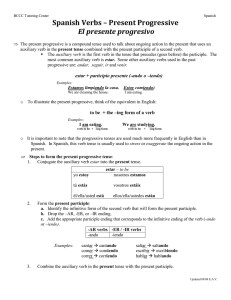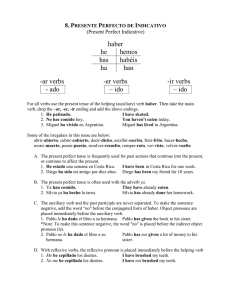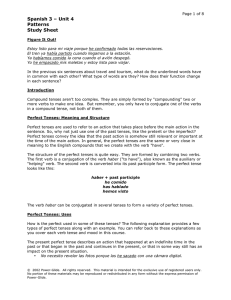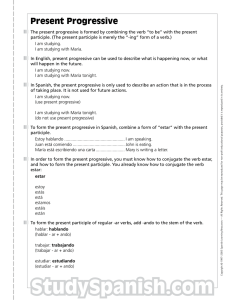Past Progressive El pasado progresivo
Anuncio
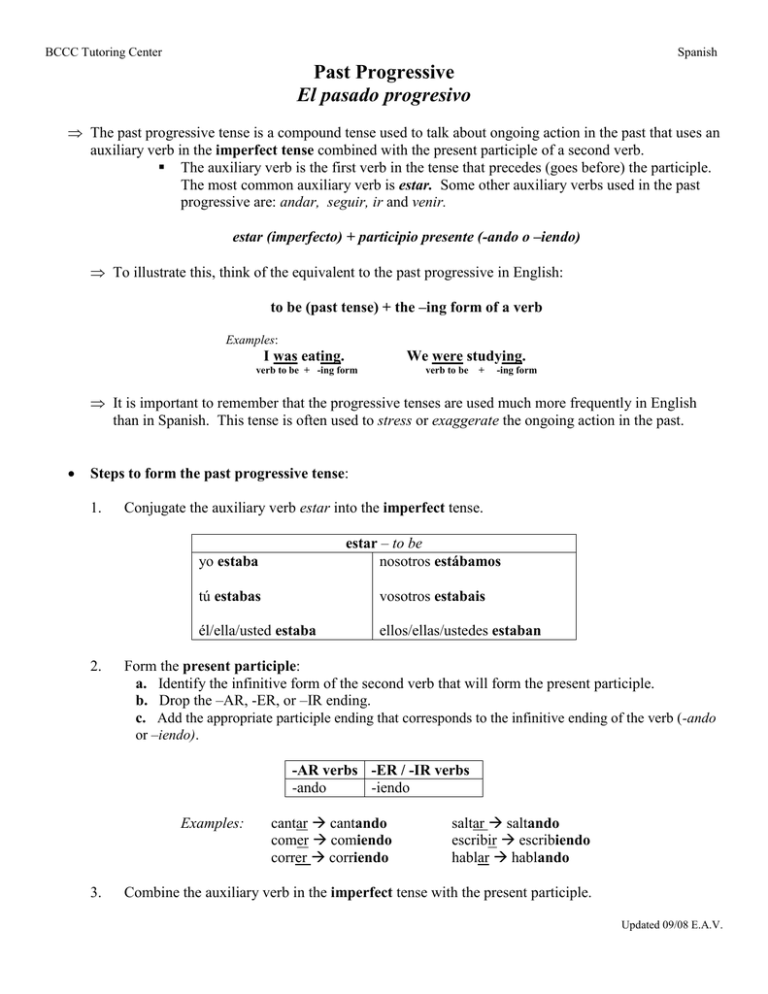
BCCC Tutoring Center Spanish Past Progressive El pasado progresivo The past progressive tense is a compound tense used to talk about ongoing action in the past that uses an auxiliary verb in the imperfect tense combined with the present participle of a second verb. The auxiliary verb is the first verb in the tense that precedes (goes before) the participle. The most common auxiliary verb is estar. Some other auxiliary verbs used in the past progressive are: andar, seguir, ir and venir. estar (imperfecto) + participio presente (-ando o –iendo) To illustrate this, think of the equivalent to the past progressive in English: to be (past tense) + the –ing form of a verb Examples: I was eating. We were studying. verb to be + -ing form verb to be + -ing form It is important to remember that the progressive tenses are used much more frequently in English than in Spanish. This tense is often used to stress or exaggerate the ongoing action in the past. Steps to form the past progressive tense: 1. Conjugate the auxiliary verb estar into the imperfect tense. estar – to be nosotros estábamos yo estaba 2. tú estabas vosotros estabais él/ella/usted estaba ellos/ellas/ustedes estaban Form the present participle: a. Identify the infinitive form of the second verb that will form the present participle. b. Drop the –AR, -ER, or –IR ending. c. Add the appropriate participle ending that corresponds to the infinitive ending of the verb (-ando or –iendo). -AR verbs -ER / -IR verbs -ando -iendo Examples: 3. cantar cantando comer comiendo correr corriendo saltar saltando escribir escribiendo hablar hablando Combine the auxiliary verb in the imperfect tense with the present participle. Updated 09/08 E.A.V. BCCC Tutoring Center Spanish Verbo Participio Pasado progresivo saltar – to jump saltando estaba saltando – I was jumping estábamos saltando – We were jumping estabas saltando – You were jumping estabais saltando – You ( pl.) were jumping estaba saltando – He/she was jumping estaban saltando – They were jumping estaba comiendo – I was eating estábamos comiendo – We were eating estabas comiendo – You were eating estabais comiendo – You ( pl.) were eating estaba comiendo – He/she was eating estaban comiendo – They were eating estaba escribiendo – I was writing estábamos escribiendo – We were writing estabas escribiendo – You were writing estabais escribiendo – You (pl.) were writing estaba escribiendo – He/she was writing estaban escribiendo – They were writing comer – to eat comiendo escribir – to write escribiendo It is important to note that all -AR and -ER verbs are regular when forming the present participle. Only some –IR stem changing verbs have irregular participles. Steps to form the present participle of -IR stem changing verbs: 1. The vowel e in the stem changes to i, e > i The vowel o in the stem changes to u, o > u 2. Add -iendo to the stem of the verb. Examples: pedir pidiendo servir sirviendo seguir siguiendo decir diciendo morir muriendo dormir durmiendo For pronunciation reasons, some verbs experience a spelling change involving the letter y. o This change occurs because any time there is an unaccented letter i between two vowels, it changes to a y. If the regular steps to forming the past participle were followed for the verb influir, the participle would look like this: influiendo. However, because there is an unaccented i between two vowels (u and e) the i changes to a y, and the correct participle is influyendo. Other examples of verbs like this: caer cayendo oír oyendo leer leyendo Updated 09/08 E.A.V. BCCC Tutoring Center Spanish Updated 09/08 E.A.V.
